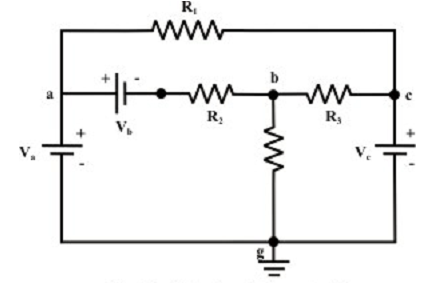Kirchhoff’s Laws
Kirchhoff’s laws are fundamental analytical tools in order to acquire the solutions of currents and voltages for any electric circuit; whether it is supplied from a direct-current system or an alternating current system. But with complicated circuits the equations connecting the currents and voltages might become too numerous that much tiresome algebraic work is include in their solutions.
Elements which generally encounter in an electric circuit can be interconnected in different possible ways. Before discussing the fundamental analytical tools which determine the currents and voltages at various parts of the circuit, some fundamental definition of the terms below are considered.

Figure: A simple resistive network
• Node- A node in an electric circuit is a point where two or more components are connected altogether. This point is generally marked with dark circle or dot. The circuit in figure below has nodes a, b, c, and g. Usually, a point, or a node in a circuit identifies a certain voltage level with respect to a reference point or node.
• Branch- A branch is a conducting path among two nodes in a circuit having electric elements. Such elements could be resistances, sources, or other elements. Figure above shows that the circuit has six branches: three resistive branches (a-c, b-c, and b-g) and three branches having voltage and current sources (a-, a-, and c-g).
• Loop- A loop is any closed path in an electric circuit that is, a closed path or loop in a circuit is a contiguous series of branches that preliminary and end points for tracing the path are, in effect, the similar node and touches no other node more than once. Figure above illustrates three loops or closed paths viz., a-b-g-a; b-c-g-b; and a-c-b-a. Further, it might be observed that the outside closed paths a-c-g-a and a-b-c-g-a are also form two loops.
• Mesh- A mesh is a particular case of loop which does not have any other loops in it or in its interior. Figure above points out that the first three loops (a-b-g-a; b-c-g-b; and a-c-b-a) just specified are also ‘meshes’ though other two loops (a-c-g-a and a-b-c-g- a) are not. With the introduction of the Kirchhoff’s laws, different kinds of electric circuits can be examined.